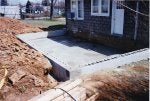You read that right. 1/2" thick. Under contract to remodel a basement, was going to grind floor for a salt and pepper finish, but discovered it's basically nothing. Thickest portions range up to 2" thick, but most are less. Easy to smash any portion with one swing of the sledge from my hefty 160 pound frame.
Funny thing is it's the second house on the same street where I found this. 1920s homes. Now worth $700-1mil.
Anyone ever encountered one so thin?
Anyway, looks like this week we're setting up the conveyor, busting up a slab, digging down, and pouring new. Yehaw!
Funny thing is it's the second house on the same street where I found this. 1920s homes. Now worth $700-1mil.
Anyone ever encountered one so thin?
Anyway, looks like this week we're setting up the conveyor, busting up a slab, digging down, and pouring new. Yehaw!







